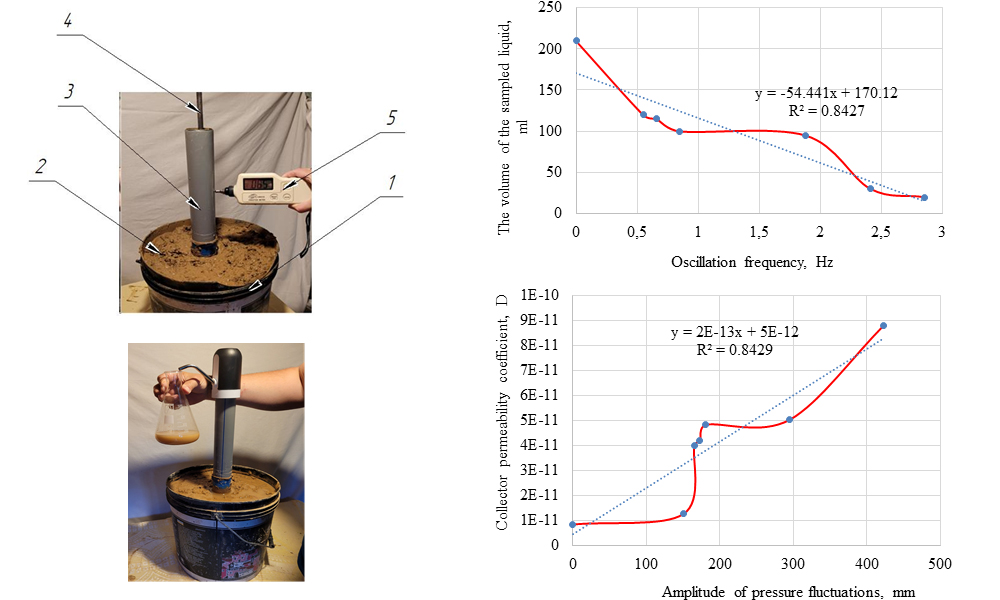Laboratory studies of induction of flow using vibratory wave draining in carbonate low-permeability reservoirs
DOI:
https://doi.org/10.15587/2706-5448.2023.291973Keywords:
oil and gas industry, laboratory unit, well, permeability, oscillation amplitude, loam, vibration waves, fluid productionAbstract
The object of the study is a laboratory unit for inducing flow to the well using vibration wave draining in carbonate low-permeability reservoirs. Vibratory wave draining is a method used to stimulate flow draining to the well. The method is based on the fact that mechanical waves generated in the soil can cause the opening of microcracks and pores, which leads to an increase in the fluid flow. Vibratory wave scouring can be effectively used to increase fluid flow in low-permeability carbonate reservoirs. Carbonate reservoirs are a common type of reservoir in the oil and gas industry. They often have low permeability, which makes it difficult to extract fluid.
With the help of the plunger device developed in the work, a fluid disturbance was created, thereby creating elastic waves in the conventional well (plastic pipe), which were measured using a manual contact vibrometer. This demonstrated the effectiveness of the vibratory method to increase the well productivity and helped to improve the permeability of the rocks, providing better access to challenge the influx of hydrocarbon products.
It is shown that with a significant decrease in the permeability of the formation well zone (FWZ), the flow induction should be started only after the restoration works. Otherwise, the well will be significantly hydrodynamically imperfect due to the quality of the reservoir opening, and the flow of production into the well will occur only through a few separate areas of the reservoir with relatively high permeability, which will lead to uneven production of the reservoir and low return of hydrocarbons. Therefore, it is advisable to use the developed method of influencing the productive layer in low-permeability rocks, such as carbonates with layers of clay, siltstones, argillites, and others, with low formation pressures.
The obtained results are based on the generation of vibrations that are transmitted to the wellbore. These vibrations can help break up contaminants and fines in carbonate rocks, facilitating the release of hydrocarbon products and improving permeability.
References
- Akulshyn, O. O., Shtaiden, B. B., Nemyrovska, L. V. (2008). Tekhnolohiia hidroimpulsno-reahentnoho vplyvu dlia stymuliatsii roboty sverdlovyn. Naftova i hazova promyslovist, 3, 36–37.
- Kvietnyi, R. N. (2001). Metody komp’iuternykh obchyslen. Vinnytsia: VDTU, 148.
- Petruniak, M., Rubel, V., Chevhanova, V., Kulakova, S. (2021). Application of grout slurries with the defecate addition for effective well cementing. Mining of Mineral Deposits, 15 (1), 59–65. doi: https://doi.org/10.33271/mining15.01.059
- Rubel, V., Rubel, V., Ziaja, J., Yaremiychuk, R. (2022). Development of a mathematical model of the operation of the swab generator valve. Technology Audit and Production Reserves, 5 (1 (67)), 6–10. doi: https://doi.org/10.15587/2706-5448.2022.265815
- Romatschke, P., Romatschke, U. (2019). Relativistic fluid dynamics in and out of equilibrium. Cambridge Monographs on Mathematical Physics. doi: https://doi.org/10.1017/9781108651998
- Gee, R., Hanley, C., Hussain, R., Canuel, L., Martinez, J. (2015). Axial oscillation tools vs. lateral vibration tools for friction reduction – what's the best way to shake the pipe? Proceedings of the SPE/IADC Drilling Conference and Exhibition, Society of Petroleum Engineers. London. doi: https://doi.org/10.2118/173024-ms
- Cheng, X., Meng, B., Han, M., Chen, H., Zhang, H. (2015). A high-efficiency transparent electrification-based generator for harvesting droplet energy. 2015 Transducers – 2015 18th International Conference on Solid-State Sensors, Actuators and Microsystems (TRANSDUCERS), 62–65. doi: https://doi.org/10.1109/transducers.2015.7180861
- Li, B. (2014). Development and pilot test of hydro-oscillator. Petroleum Drilling Techniques, 42 (1), 111–113.
- Guan, Z., Zhang, H., Zhang, W., Liu, Y., Liang, D. (2014). Equipment and technique for improving penetration rate by the transformation of drill string vibration to hydraulic pulsating jet. Petroleum Exploration and Development, 41 (5), 678–683. doi: https://doi.org/10.1016/s1876-3804(14)60081-1
- Derzhavni sanitarni normy vyrobnychoi zahalnoi ta lokalnoi vibratsii DSN 3.3.6.039-99 (1999). Available at: https://zakon.rada.gov.ua/rada/show/va039282-99#Text

Downloads
Published
How to Cite
Issue
Section
License
Copyright (c) 2023 Victoriia Rubel, Vyacheslav Rubel

This work is licensed under a Creative Commons Attribution 4.0 International License.
The consolidation and conditions for the transfer of copyright (identification of authorship) is carried out in the License Agreement. In particular, the authors reserve the right to the authorship of their manuscript and transfer the first publication of this work to the journal under the terms of the Creative Commons CC BY license. At the same time, they have the right to conclude on their own additional agreements concerning the non-exclusive distribution of the work in the form in which it was published by this journal, but provided that the link to the first publication of the article in this journal is preserved.







